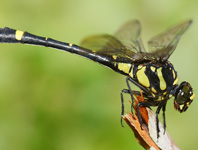Abstract
Two new species of the family Microlaimidae Micoletzky, 1922 are described and illustrated from the Black Sea. Aponema pontica sp. n. is morphologically closest to A. torosum in the shape of the body and spicules, size of amphids, but differs in having small and triangular cardia, absence of constriction in head region, shape of gubernaculum apophyses, rounded and weakly sclerotised lumen of pharyngeal bulb and longer spicules. Microlaimus paraglobiceps sp. n. morphologically resembles M. globiceps de Man, 1880 in the shape of the body, structure of the male sexual organs and presence of precloacal pore, but the main difference is a shorter body, cuticle finely annulated all over the body and absence of sexual dimorphism in the size of amphideal fovea.
References
Gallucci, F., Moens, T. & Fonseca, G. (2009) Small-scale spatial patterns of meiobenthos in the Arctic deep sea. Marine Biodiversity, 39, 9–25.
https://doi.org/10.1007/s12526-009-0003-x
Gambi, C., Vanreusel, A., Danovaro, R. (2003) Biodiversity of nematode assemblages from deep-sea sediments of the Atacama Slope and Trench (South Pacific Ocean). Deep-Sea Research, Part I: Oceanographic Research Papers, 50, 103–117.
https://doi.org/10.1016/S0967-0637(02)00143-7
Gerlach, S.A. (1950) Die Nematoden-Gattung Microlaimus. Zoologische Jahrbücher (Systematic), 79, 188–208.
Gerlach, S.A. (1953) Freilebende marine Nematoden aus dem Küstengrundwasser und aus dem Brackwasser der Chilenischen Küste. Acta Universitatis Lundensis, 49 (10), 1−37.
Giere, O. (2009) Meiobenthology. The microscopic motile fauna of aquatic sediments. 2nd Edition. Springer, Berlin Heidelberg, 527 pp.
Guilini, K., Bezerra, T.N., Eisendle-Flöckner, U., Deprez, T., Fonseca, G., Holovachov, O., Leduc, D., Miljutin, D., Moens, T., Sharma, J., Smol, N., Tchesunov, A., Mokievsky, V., Vanaverbeke, J., Vanreusel, A., Venekey, V. & Vincx, M. (2017) NeMys: World Database of Free-Living Marine Nematodes. Available from http://nemys.ugent.be (accessed 31 August 2017)
Jensen, P. (1979) Nematodes from the brackish waters of the southern archipelago of Finland. Benthic species. Annales Zoologici Fennici, 16 (3), 151–168.
Kulakova, I.I. (2013) Present state of fauna free-living nematodes of the Odessa Sea region. Odesa National University Herald, Biology, 18, 3 (32), 49−60.
https://doi.org/10.18524/2077-1746.2013.3(32).45279
Lambshead, P.J.D., Brown, C.J., Ferrero, T.J., Hawkins, L.E., Smith, C.R. & Mitchell, N.J. (2003) Biodiversity of nematode assemblages from the region of the Clarion-Clipperton Fracture Zone, an area of commercial mining interest. BioMedCentral Ecology, 3, 1−12.
https://doi.org/10.1186/1472-6785-3-1Liu, X.S., Zhang, Z.N. & Huang, Y. (2007) Sublittoral meiofauna with particular reference to nematodes in the southern Yellow Sea, China. Estuarine, Coastal and Shelf Science, 71 (3–4), 616–628.
https://doi.org/10.1016/j.ecss.2006.09.013
Mureşan, M. (2012) Assessment of free-living marine nematodes community from the NW Romanian Black Sea shelf. Geo-Eco-Marina, 2012, 133−145.
Mureşan, M. (2014) Diversity and distribution of free-living nematodes within periazoic level on the Romanian Shelf of the Black Sea. Geo-Eco-Marina, 2014, 19−28.
Revkova, T.N. (2014) Species and trophic structure of free-living nematodes in industrial pollution waters (Sevastopol Bay, Black Sea). In: Proceedings of the IGCP-610 Second Plenary Meeting and Field Trip, Azerbaijan, Baku, 12–20 October, pp. 214–116.
Semprucci, F., Colantoni, P., Baldelli, G., Sbrocca, C., Rocchi, M. & Balsamo, M. (2013) Meiofauna associated with coral sediments in the Maldivian subtidal habitats (Indian Ocean). Marine Biodiversity, 43, 189–198.
https://doi.org/10.1007/s12526-013-0146-7
Sergeeva, N.G. (1976) New data on taxanomy of the subfamily Microlaiminae (Nematoda). Zoologichesky Zhurnal, 55, 1090–1094.
Sergeeva, N.G. (2003) Meiobenthos of area with methane gas seeps. In: Eremeev, V.N. & Gaevskaya, A.V. (Eds.), Modern condition of biological diversity in near-shore zone of the Crimea (the Black Sea sector). Ekosi-Gidrophizika, Sevastopol, pp. 258–267.
Sergeeva, N.G. & Kolesnikova E.A. (2003) Meiobenthos taxonomical composition in the Crimean region. In: Eremeev, V.N. & Gaevskaya, A.V. (Eds.), Modern condition of biological diversity in near-shore zone of the Crimea (the Black Sea sector). Ekosi-Gidrophizika, Sevastopol, pp. 246–247.
Sergeeva, N.G., Gooday A.J., Mazlumyan, S.A., Kolesnikova, E.A., Lichtschlag, A., Kosheleva, T.N. & Anikeeva, O.V. (2012) Meiobenthos of the oxic/anoxic interface in the Southwestern region of the Black Sea: abundance and taxonomic composition. In: Altenbach, A.V., Bernhard, J.M. & Seckbach, J. (Eds.), Anoxia: paleontological strategies and evidence for eukaryotes Survival. Springer, Dordrecht, pp. 369–401.
https://doi.org/10.1007/978-94-007-1896-8_20Tchesunov, A.V. (2014) Order Desmodorida De Coninck, 1965. In: Schmidt-Rhaesa, A. (Ed.), Handbook of Zoology. Gastrotricha, Cycloneuralia, Gnathifera. Vol. 2. Nematoda. De Gruyter, Hamburg, pp. 399–434.
Tsalolikhin, S.Ya. (1980) Free-Living Nematodes of Lake Baikal. Nauka, Novosibirsk, 119 pp.
Turpeenniemi, T.A. (1997) Four new nematode species from the Bothnian Bay, Northern Baltic Sea, with a redescription of Microlaimus globiceps De Man, 1880 (Nematoda). Nematologica, 43 (1), 31–58.
https://doi.org/10.1163/004725997X00034

